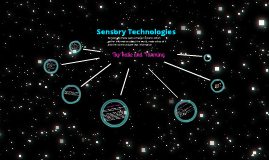Earth and Space presentation
Transcript: Sensors are those parts of larger systems which gather information about the world, make sense of it and then communicate that information Sensors are constantly developing and improving and will be used in many future projects and missions, for example: Europa Jupiter System Mission -Launched in 2020 -NASA and ESA -Will explore the emergence of habitable worlds around the gas giant planets -The mission focuses on the Galilean moons Europa and Ganymede, but also investigates Io, Callisto, and the Jupiter system as a whole How it would work: Orbiters would enable science investigations, using their science instruments and will: -search for the presence and extent of subsurface oceans -characterize ice shells & subsurface water -compare exospheres, plasma environments, and magnetospheric interactions By:Katie and Yanming Without the development of new sensory technology, NASA's exploration would not proceed These sensory instruments are vital in order to: -collect and process scientific data -to answer compelling questions -to provide crucial knowledge (enable robotic missions) -many of these technologies are also used to support human missions (test safety environment) *mars article -ice-penetrating radar -visible–infrared spectrometer - ultraviolet spectrometer -ion and neutral mass spectrometer -magnetometer Passive Sensors- -Detect natural energy (radiation) that is emitted or refllected by the object/scene being observed -Most common source of radiation reflected is sunlight -Most operate in visible, infared, thermal infared and microwave portion of the electromagnetic spectrum Ex1. Magnetometer- an instrument used for measuring magnetic forces Ex2. Spectrometer- device designed to detect, analyze, and measure spectral content of incident electromagnetic radiation Active Sensors- -Provide own source of energy (radiation) to illuminate the objects they observe -Most operate in microwave portion of electromagnetic spectrum Ex. Radar- radio detection and ranging sensor that emits microwave radiation in pulses out of antenna, when the energy reaches the target some in reflected back; the time it took to travel back determines the range and distance of the object Sensory Technology Used in Europa Jupiter System Mission The cost of sensory technologies can range anywhere from a few hundred million to even billions Ex. A space-based instrument is being built to monitor major air pollutants across the North American continent hourly during the daytime The instrument, to be completed in 2017 at a cost of $90 million, will ride on a commercial satellite that orbits about 22,000 miles above Earth's equator. Types of Sensors Future Projects Technology developments will help study the themes of: Weather, surface and interior, carbon cycles, ecosystems; water and energy cycles, climate variability and change, and atmospheric composition Cost of Sensory Technology Sensory Technologies Future Sensory Technologies Importance of Sensory Technologies

















